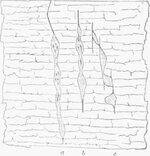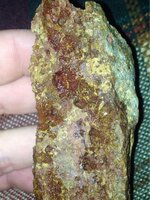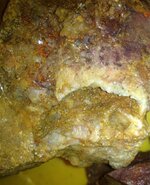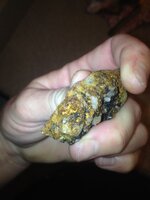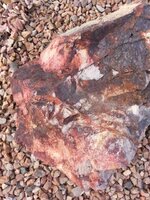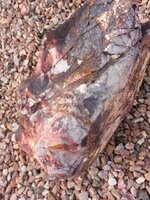I've been talking to locals and studying the local geology in my area. Apparently the veins around here occasionally form pockets and there will be nice concentrations of gold in one area of the vein and the ore above and below the pocket doesn't have much gold at all because it's all been concentrated into those pockets. Do you have any experience with this? Are you hunting for those pockets or do you just collect all the ore and crush it? I found a very small vein, it's an offshoot of a much bigger vein that the old miners sunk several very deep shafts into and did a lot of little digs all along that vein. This little vein I found has never been dug, about twenty or thirty feet of this little vein that once was under ground is now just a pile of crumbled oxidized ore where erosion has let it keep piling up on itself as the hillside wears away. I decided to excavate this little vein to look for a pocket of gold. I've been taking all the ore home, it doesn't hit on a detector at all and I've not found any coarse or detectable gold out of this vein yet but I can grab a pan full of peices from that little vein and crush it and pan it, there is a bunch of very fine gold in there. If every little piece of the vein has a small bit of gold in it, do you think this is a possible contender for a pocket if i keep digging? Also, based on what I've told you is this high grade ore? It seems like if every piece I've found is showing color then this stuff probably runs at least an ounce per ton I'd think.
You are using an out of date browser. It may not display this or other websites correctly.
You should upgrade or use an alternative browser.
You should upgrade or use an alternative browser.
Looking for pockets or high grade ore
- Thread starter Kingclean
- Start date
Goodyguy
Gold Member
- Mar 10, 2007
- 6,489
- 6,895
- Detector(s) used
- Whites TM 808, Whites GMT, Tesoro Lobo Super Traq, Fisher Gold Bug 2, Suction Dredges, Trommels, Gold Vacs, High Bankers, Fluid bed Gold Traps, Rock Crushers, Sluices, Dry Washers, Miller Tables, Rp4
- Primary Interest:
- All Treasure Hunting
Very good ore!
Metal detectors seldom pick up gold in the ore unless it is extremely rich.
Typically pockets of gold are found on horizontal offshoots of vertical veins where the hydrothermal fluid that transported the gold through cracks (veins) deposited it into a pocket or vug (hollow area) where it collected in the host rock or ground.
A pocket could be anywhere along a vein so keep looking.
In the meantime collect all that ore you can get your hands on!
GG~
Metal detectors seldom pick up gold in the ore unless it is extremely rich.
Typically pockets of gold are found on horizontal offshoots of vertical veins where the hydrothermal fluid that transported the gold through cracks (veins) deposited it into a pocket or vug (hollow area) where it collected in the host rock or ground.
A pocket could be anywhere along a vein so keep looking.
In the meantime collect all that ore you can get your hands on!
GG~
Last edited:
Oakview2
Silver Member
Maybe you run into something like this...
The-Vug.com Presents, Collector's Edge Press Release: New Discovery of Superb Crystallized Gold, Mockingbird Mine, Mariposa County, California by Tom Gressman
The-Vug.com Presents, Collector's Edge Press Release: New Discovery of Superb Crystallized Gold, Mockingbird Mine, Mariposa County, California by Tom Gressman
tamrock
Gold Member
- Jan 16, 2013
- 14,955
- 29,793
- Detector(s) used
- Bounty Hunter Tracker IV
- Primary Interest:
- All Treasure Hunting
One Oz. a ton is nothing to balk at these days. As mentioned, a rich pocket or (vug) of gold have been found, but are very rare and stories of finds like them get told over again to the point of legends and thoughts these deposits of gold are still there under your feet. A famous vug was found in 1914 in Cripple Creek Colorado. Today there is a large active pit gold operation and a couple small underground operations. Who knows? maybe an other legendary deposit like it will be found again?
The Cripple Creek gold deposits occur within a seven square mile (18 sq. km), 30 million year old, volcanic-intrusive complex (diatreme) that erupted and intruded through rocks that are over one billion years old. The diatreme-intrusive complex is 6.4 km long and 3.2 km wide. The rocks within the complex consist mostly of breccias, dikes, sills, and flows with minor amounts of fossil-bearing lake sediments, sandstones, conglomerates, and fresh-water limestones.
The Cresson is named for the historic underground mining operation of the same name. The Cresson is famous for the great gold find of the District, the “Cresson Vug.� A vug is a cavity in the rock, lined with crystals somewhat like a geode. The Cresson Vug produced 60,000 troy ounces of gold that was essentially picked from the walls of a room sized void encountered about 1,200 feet below the surface in 1914.
The gold mineralization followed the emplacement of the volcanic rocks and may have occurred over a time period that lasted as long as two million years. Most of the gold was localized along major structural zones within the volcanic complex. The ore bodies occur as (1) deposits of rich, narrow, gold-telluride veins with quartz, pyrite, and fluorite and (2) deposits of low-grade, disseminated, microcrystalline, native gold attached to pyrite. Most of the gold mined in the early days of the district came from the high-grade gold telluride veins.
The Cripple Creek gold deposits occur within a seven square mile (18 sq. km), 30 million year old, volcanic-intrusive complex (diatreme) that erupted and intruded through rocks that are over one billion years old. The diatreme-intrusive complex is 6.4 km long and 3.2 km wide. The rocks within the complex consist mostly of breccias, dikes, sills, and flows with minor amounts of fossil-bearing lake sediments, sandstones, conglomerates, and fresh-water limestones.
The Cresson is named for the historic underground mining operation of the same name. The Cresson is famous for the great gold find of the District, the “Cresson Vug.� A vug is a cavity in the rock, lined with crystals somewhat like a geode. The Cresson Vug produced 60,000 troy ounces of gold that was essentially picked from the walls of a room sized void encountered about 1,200 feet below the surface in 1914.
The gold mineralization followed the emplacement of the volcanic rocks and may have occurred over a time period that lasted as long as two million years. Most of the gold was localized along major structural zones within the volcanic complex. The ore bodies occur as (1) deposits of rich, narrow, gold-telluride veins with quartz, pyrite, and fluorite and (2) deposits of low-grade, disseminated, microcrystalline, native gold attached to pyrite. Most of the gold mined in the early days of the district came from the high-grade gold telluride veins.
ssdevilfish
Jr. Member
- Jan 8, 2014
- 90
- 43
Tamrock thank you for such incredible detail in your post. An excellent summary like that can only come from an educated miner. Sure would like to walk in Rockies with you some time.
tamrock
Gold Member
- Jan 16, 2013
- 14,955
- 29,793
- Detector(s) used
- Bounty Hunter Tracker IV
- Primary Interest:
- All Treasure Hunting
Well I've been around mining for some time now. Not sure an educated miner is how I would see it? Most good information about the riches found in the USA can be found in the history books. I so enjoy reading as much as I can on all the mining regions of this country. You can find out allot of information from what was done in the past. I've never heard gold was mined in the Henry Mountains of Utah. Well on 2-14-14 I made a visit to see these folks who are going underground in the Henry mountains to mine gold. They tell me gold has been mined there off and on over many years. I also read of a lost Spanish treasure in the Henry mountains for the first time.Ancient Lost Treasures ? View topic - The Lost Spanish Mine of the Henry Mountains, a Story ... I thought only uranium mining was done in that region. The details in my post I just cut and paste info I found on line. I read about the famous Cripple Creek vug a long time ago.Tamrock thank you for such incredible detail in your post. An excellent summary like that can only come from an educated miner. Sure would like to walk in Rockies with you some time.
DesertNuggets
Hero Member
A nice pocket of gold. The stuff dreams are made of. 

- Thread starter
- #8
Thanks for the responses. I am looking for info on the pockets that occur within the matrix of the actual veins, in the areas where the vein pinches and swells forming 'pockets' within the actual vein itself. What I've read suggests that these are most likely to form in a smaller vertical vein because super gene enrichment is more prominent on a vertical vein. If anyone is wondering, super gene enrichment is where a vertical vein is formed, and over time the oxidized ore above the water line is releasing the metals inside it where they can move deeper in the vein. Often times they will get caught in the spot where the vein pinches out and becomes very thin. If this is occurring on any given vein then you will have portions above and below each pocket in the vein that have little or no gold values because it's all been concentrated down into those pockets. That's my take on it from what I've read anyway. Also, I have no idea if the ore is actually an ounce per ton. I just know that a couple golf ball sized pieces from any where off the vein will show many colors in a pan. They are very small but still a good sprinkling of colors. I just compared it to the dirt I drywash, because even in good ground I'm drywashing it is possible to take a big pan of dirt and not get a single color because the gold is so spread out through the gravel. I just assumed that with gold in every tiny sample of this vein so far that it would run at least an ounce per ton. That is just a guess though and I might be completely wrong, those little tiny pieces of gold take a while to add up.
dave wiseman
Hero Member
Just because a vein has made pockets or enrichments,dosen't mean it will continue making them.All veins that carry gold do not make pockets.Some mines just had fine or micro gold or gold tied up in pyrites.Any gold in your samples from a quartz vein are worth pursuing if you've the time,energy and no quit attitude as the old saying goes...who knows what's beyond the point of a pick?Yes,where veins pinch and swell,where a vein is faulted,where the country rock changes,before or after a bend in the vein,where a cutter,stringer or clay seam contact meet the vein may all be likely places for an enrichment in a gold bearing vein....but often these circumstances produce nothing,even if a vein 10 feet away produced big pockets.What's true in one area mostly holds no water in another.The gold makes where it wants to.Have found many small pockets on gold bearing veins with no obvious geological signs that it would make except that I was following the lead(pronounced leed)as taught to me by old professional prospecters and miners.Keep following that yellow,whether up,down or in on that vein.
- Thread starter
- #11
Thanks for the advice David. Is the technique of following the lead, taking a test, and if you find gold, take another test in the same direction. If there is less gold in the second test try another direction? I am just baffled by how one goes about choosing which vein to dig, I'm guessing the first good sign would be gold in tests of the vein. But like you said this doesn't guarantee a pocket or an enrichment with further digging. So what would keep you digging on a particular vein? I mean even if you get good samples the vein next to you with no visible gold in the samples might have less gold in the tests because there is much more gold it's concentrated in pockets, and smaller areas making the tests inaccurate as far as predicting the veins value. I am just trying to wrap my head around the most basic guidelines for choosing a vein to explore because right now, it seems like any hydrothermal vein in a gold bearing area has about as much chance as the next one. I know there are little tricks like knowing which minerals are usually locked up in a gold vein, but it also seems to me is that if your in a gold bearing area, almost every vein in that general area will contain some of the minerals that are found with gold, again leaving you with a pretty vague idea of where to start and a whole bunch of veins to choose from. Sorry for the barrage of questions, let me ask you a simpler one. Based on your experience would you keep digging this vein I've found or search for another? This little one I've found is very small compared to the giant one that is running near it. Also, the miners must've been pretty busy with the shafts nearby because it doesn't look like anyone has ever touched this vein. Im also thinking it may have been under a few inches of dirt until recently. Anyway, with the way the veins been eroding untouched for so long, it just looked like someone gathered about a half a wheelbarrow of ore and then dumped it up on the hillside. So there is just that little pile of ore where the vein has been collapsing back on itself. It is right up against a fault line, as there is a giant ridge of rock pocking out under the ground right behind where the vein pops out of the ground. I have moved a few feet of dirt and there is a lot more ore under the ground right there but it's still all broken up and oxidized so I haven't dug deep enough to find the vein still intact. Having tested hundreds of samples from as many veins in this same area, I figured this one would be a good starting point just because all the ore is showing fine gold in every test. This gold is fine but sort of "fluffy", it looks like some of the peices would be bigger if I wasn't having to pulverize them with a steel rod before panning the gold out. Any advice or opinions are appreciated.
dave wiseman
Hero Member
Your on the gold now so stick with that one for awhile.When to quit digging on a vein is up to you.I've quit on veins and gone back to them and found a small pocket.I would dig on that vein and also take smaller samples of other veins at the same time.Just because a vein isn't showing color after a few samples doesn't mean that it wouldn't show color deeper or further in,or maybe not.You must keep in mind that it's likely you aren't trying to make a gold mine,but recover high grade species and/or pockets.Here is one important tip.Check those fine colors with a loupe and see if there is any minute quartz attached to it.This clue and getting more and more color in one spot may produce a pocket/or may not.The size of a vein doesn't mean one vein would carry more gold than a smaller vein.Keep all your samples well marked as to know what came from where.Any gold in a quartz vein is obviously a good sign as how many veins carry gold.Keep your finds to yourself and never quit on gold to find bigger gold.Read the good books like Handbook for Prospectors by Richard Pearl or older editions by VonBernewitz and How to find gold by Ion Idreiss..these are available online at varying prices.Make them your bible and must be read over and over as one never stops learning this stuff.Here's a link to my quickly written paper...http://www.goldplacer.com/hardrockgold.htm...Good luck and keep asking 

Last edited:
- Thread starter
- #13
Ok cool, thanks Dave. I will keep testing and digging on this vein and see what comes of it. Thanks for the advice, great paper. The link didn't seem to work at first but then I clicked the "lode prospecting" section and your paper came up.
dave wiseman
Hero Member
It was just a quick reply to a fellow some years back on another forum.There's lot's more to it than in the paper,but it gives the basics.You learn as you go by doing the field work,reading and asking  like I've often posted on various forums there's very little competition in this quartz vein prospecting.Most people won't stick with it.
like I've often posted on various forums there's very little competition in this quartz vein prospecting.Most people won't stick with it.
 like I've often posted on various forums there's very little competition in this quartz vein prospecting.Most people won't stick with it.
like I've often posted on various forums there's very little competition in this quartz vein prospecting.Most people won't stick with it.My favorite Dave points on this ;
Just because a vein has made pockets or enrichments,dosen't mean it will continue making them.All veins that carry gold do not make pockets.
Have found many small pockets on gold bearing veins with no obvious geological signs that it would make except that I was following the lead.
Just because a vein isn't showing color after a few samples doesn't mean that it wouldn't show color deeper or further in,or maybe not.You must keep in mind that it's likely you aren't trying to make a gold mine,but recover high grade species and/or pockets.
The size of a vein doesn't mean one vein would carry more gold than a smaller vein.Keep all your samples well marked as to know what came from where.

Just because a vein has made pockets or enrichments,dosen't mean it will continue making them.All veins that carry gold do not make pockets.
Have found many small pockets on gold bearing veins with no obvious geological signs that it would make except that I was following the lead.
Just because a vein isn't showing color after a few samples doesn't mean that it wouldn't show color deeper or further in,or maybe not.You must keep in mind that it's likely you aren't trying to make a gold mine,but recover high grade species and/or pockets.
The size of a vein doesn't mean one vein would carry more gold than a smaller vein.Keep all your samples well marked as to know what came from where.

Goodyguy
Gold Member
- Mar 10, 2007
- 6,489
- 6,895
- Detector(s) used
- Whites TM 808, Whites GMT, Tesoro Lobo Super Traq, Fisher Gold Bug 2, Suction Dredges, Trommels, Gold Vacs, High Bankers, Fluid bed Gold Traps, Rock Crushers, Sluices, Dry Washers, Miller Tables, Rp4
- Primary Interest:
- All Treasure Hunting
Here is an old prospectors handbook from 1911 full of good info and it's free to read online........
The prospector's handbook, a guide for the prospector and traveller in search of metal-bearing or other valuable minerals
Go for the gold
GG~
The prospector's handbook, a guide for the prospector and traveller in search of metal-bearing or other valuable minerals
Go for the gold
GG~
dave wiseman
Hero Member
A good read...
chriseneim
Sr. Member
- May 5, 2013
- 342
- 146
kazcoro
Hero Member
- Feb 11, 2013
- 876
- 357
- Detector(s) used
- Gold Bug Pro, Gold Buddy drywasher, Black Magic, Pro Gold recirc, Custom highbanker/2.5" dredge, Roadrunner Member
- Primary Interest:
- Prospecting
CRUSH AND PAN
Mad Machinist
Silver Member
Top Member Reactions
-
 2307
2307 -
 1113
1113 -
 1037
1037 -
 899
899 -
 838
838 -
 770
770 -
 754
754 -
 736
736 -
 606
606 -
 508
508 -
 490
490 -
 477
477 -
 447
447 -
 420
420 -
 401
401 -
 398
398 -
O
398
-
 394
394 -
 384
384 -
 376
376
Users who are viewing this thread
Total: 2 (members: 0, guests: 2)


